#Mathsconf18: Atomisation Pt 2
Atomisation: Breaking down your teaching as you have never seen before…
On Saturday 9th March I delivered a workshop at the La Salle Mathematics Conference in Bristol. This blog post is a summary of some of the points made in the session.
For this workshop, I chose to look at an uncontroversial topic such as Angles on parallel lines. I think it’s uncontroversial because teachers know that it is an undeniable part of geometry that is commonly assessed. Also, I think it’s a topic which is taught with a poor sequence of examples. Lots of angle problems on parallel lines feels like an angle chase – when you find one angle then how can you find the other angle. However, in the process, pupils can’t have the rich mathematical discussion between the relationships of different angle facts on parallel lines. Part of teaching this topic effectively is dependent on the sequence in which the examples are organised.
When I started making the worked examples for this topic, I thought about the simplest application of angles on parallel lines for each angle fact and the most complex application. What I realised is that I could have spent hours or even days making lots of different worked examples. To avoid this, I thought of how I could cover all the myriad of complexities for each angle fact within the fewest number of worked examples.
The first step was to write out all the sub-tasks that I planned to teach:
– Vertically Opposite Angles are Equal
– Alternate Angles are Equal
– Co-interior Angles sum to 180o
– Corresponding Angles are Equal
– Basic Angle facts on parallel lines
– Angles on parallel lines – Algebraic
o Simplified expressions equal to 180o or 360o
o Simplified expressions equal to form an equation with unknowns on both sides.
After I listed the sub-tasks, I realised that I wanted to try a different pedagogical approach from the status quo approach. Historically, pupils are told that one unknown and one known are equal, and they are to accept it, and then identify the unknown and known angle pair which are equal in a similar looking example. Instead, I showed a selection of worked examples where the angles were of equal size, and I would state that these two angles are equal. I used Geogebra which is an online graphing programme where I would have an interactive set up so if I moved one of the parallel lines or the traversing line, the equal-sized angles would change from what they were before, but they would still be equal.
So, using a sequence of worked examples, I would
1) Show the relationship with the position of angles and the angle fact
2) Find the missing angle
3) Find the missing angle by using a basic angle fact
NOTE: Diagrams aren’t drawn to scale here.
Vertically Opposite Angles are equal
Here is an example sequence for Vertically Opposite angles being equal
Show the Relationship
At this point, I transitioned to asking pupils in a whole class discussion the size of the unknown angles because they had seen the relationship between the position of two vertically opposite angles.
I deliberately used more challenging examples for pupils to identify one missing angle which is vertically opposite to one known angle. This is because I knew it is these type of angle problems, they would struggle with the most so I went through it with them so they would be successful when they would attempt similar issues independently. I felt that showing the relationship was explicit enough for pupils to attempt the simplest applications of identifying vertically opposite angles being equal.
The third section is using basic angle facts from the list below:
- Angles in a triangle sum to 180o
- Angles in a quadrilateral sum to 360o
- Angles on a straight-line sum to 180o
- Angles around a point sum to 360o
To either use the angle fact to determine one of the two vertically opposite angles or find one of the vertically opposite angles to then find another angle using one of the basic angle facts.
Here are some worked examples of this with an explanation:
I made Example 4 deliberately to highlight that the small triangle FCB and the large triangle KCE have the same angles.
In Example 5 and 6 I have included 2 parallel lines and 1 parallel line segment to allow Example 5 to include an opportunity to use the ‘Angles around a point sum to 360o’ fact. Similarly, in Example 6 I deliberately didn’t label the vertically opposite angle because I want pupils to start finding angles that aren’t labelled but are required to find another unknown angle.
In summary, I followed the sequence structure of:
- Show the relationship
- Find the missing angle using the angle fact given
- Find the missing angle fact using basic angle facts to then determine angles using the new angle facts learnt.
Alternate Angles are equal
Here is a worked example sequence showing the relationship in positioning of Alternate Angles being equal
Now using the same geometric structure as the worked examples used to show the relationship of alternate angles, I’m asking pupils to find the size of the missing angle:
Here is a sequence of worked examples where basic angle facts have been interleaved:
Co – Interior Angles sum to 180o
Here is a worked example sequence for Co-interior angles summing to 180o
In Example 7 and 8, pupils can see that each triangle formed by both traversing lines and one of the parallel lines all have the same size angles.
Here are examples where pupils are asked to use the fact that co-interior angles sum to 180o to find the missing angle:
In the last two examples we can explore so many interesting mathematical patterns between co-interior angles and parallel lines. In Example 6, A = I and G = C
Here is the next section of worked examples where basic angle facts are being interleaved:
Corresponding Angles are Equal
Here is a worked example sequence for Corresponding angles being equal
Here is a worked example sequence where pupils are using the angle fact that corresponding angles are equal to find the missing angle:
Here is a worked examples sequence where basic angle facts are being interleaved with the angle fact that corresponding angles are equal:


























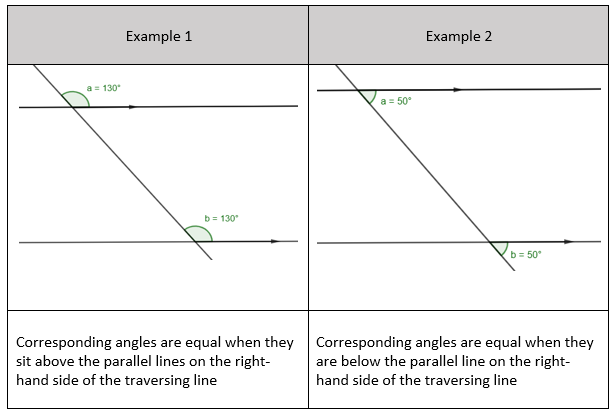
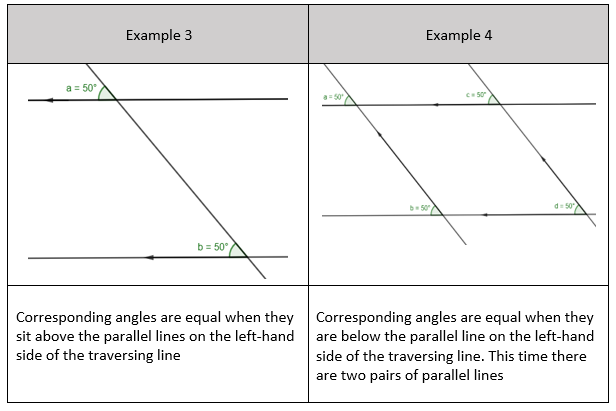
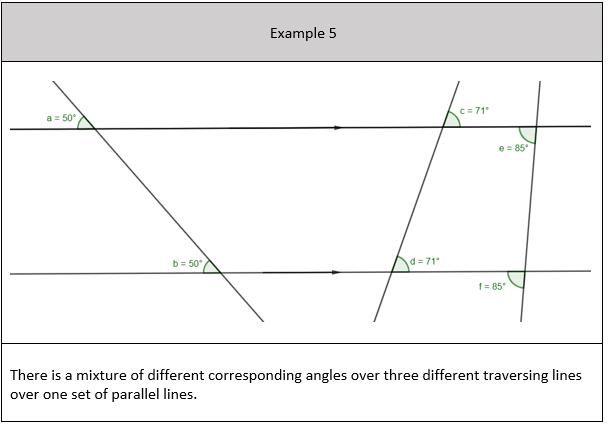

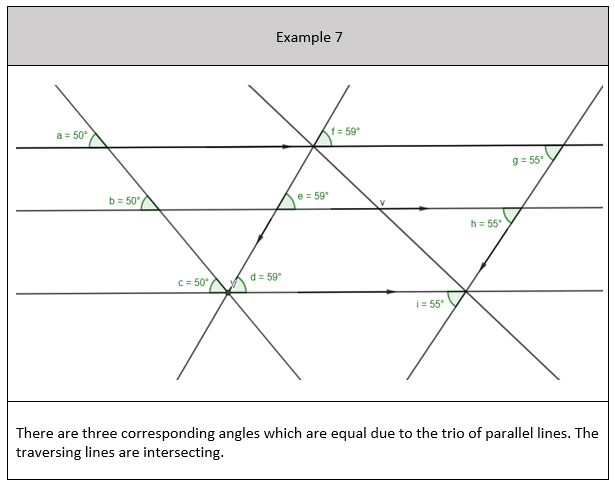


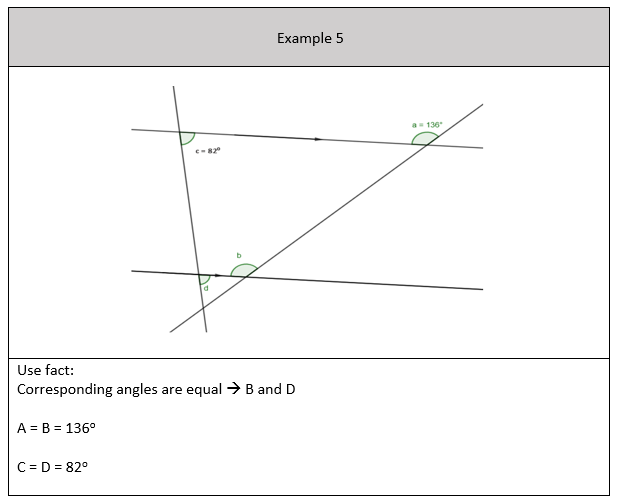
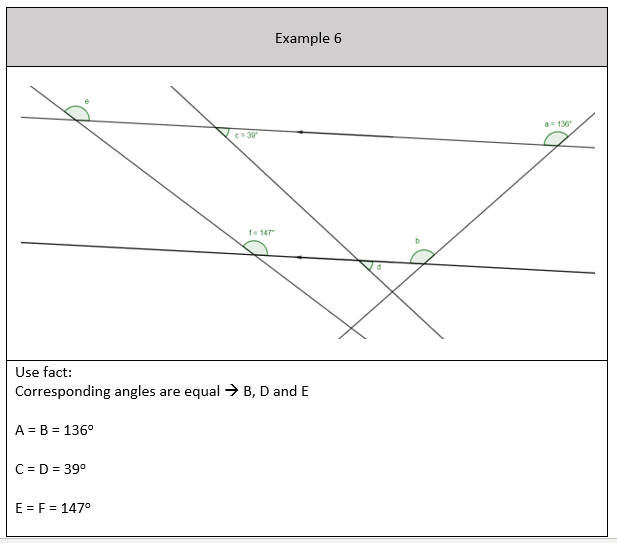


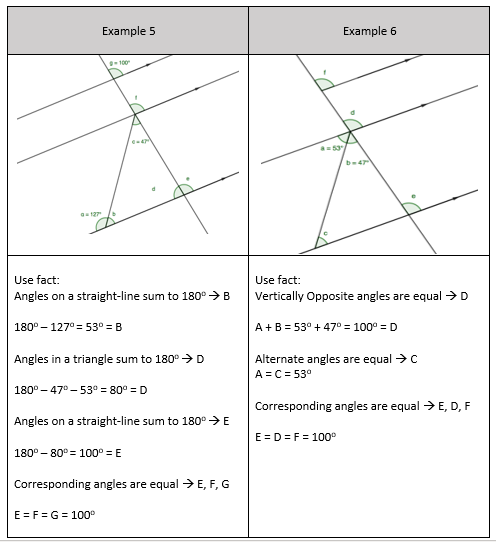

Leave a Reply
You must be logged in to post a comment.